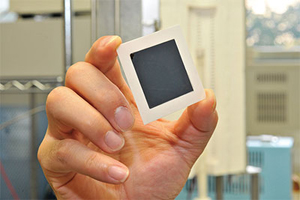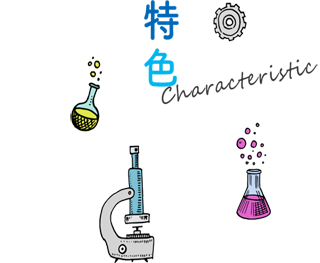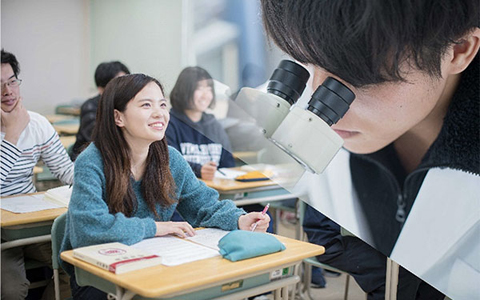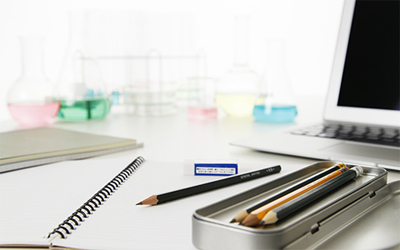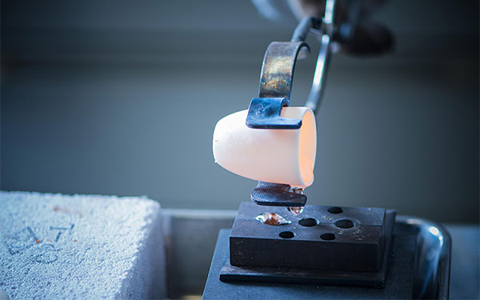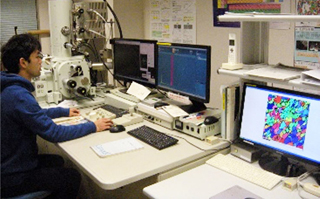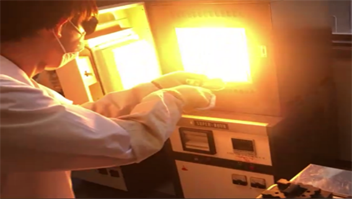Materials Design Engineering
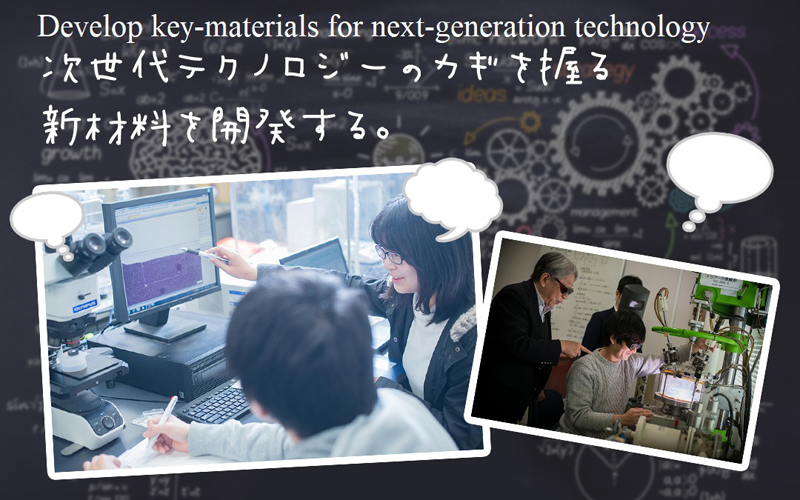
Development of eco-friendly fuel cell materials in next-generation
|
Currently, household fuel cells that can be installed in each household are on sale. A fuel cell is an energy-saving and environment-friendly next-generation power generation system. It is extremely efficient because it directly produces electricity using a chemical reaction that produces water from hydrogen and oxygen, and it only discharges water. The Materials Design Engineering Course also conducts research and development of a type called solid oxide fuel cell (SOFC). The photo shows the electrode plate used in it, which is an important part that determines the performance of the fuel cell. This is made of ceramic material. In order to increase the output, it is necessary to utilize the knowledge of materials science and engineering to select the material and control the structure at the atomic level. SOFC is expected to be applied to various applications such as large-scale power generation and fuel cell vehicles in addition to household power sources. We are also working on research every day to contribute to solving environmental and energy problems. |
|
|
Have fun and a fulfilling life for making good materials
Industry is now making great strides towards a smart and sustainable society, but various challenges are emerging in achieving these. Only the soft side tends to be highlighted, but the research and development of the hard side such as the innovative sensor that handles a large amount of data for the realization of AI has been delayed. In order to break through these barriers, materials and device innovation is essential.
The Materials Design Engineering course was born to meet such social needs. When you think of "design," you may think of a picture or a design (graphic), but it means "plan something for a specific role, purpose, or effect." In recent years, the problem-solving process of "design thinking" has been attracting attention, and the Materials Design Engineering Course provides an educational program to develop the ability to create innovative materials based on that design thinking. Would you like to live a fulfilling campus life with the Materials Design Engineering course?
|
|
2nd year
Chemical Experiments, Physical Experiments, English for Science and Engineering I, English for Science and Engineering II, Differential Equations I and Exercise, Differential Equations II, Mechanics, Electromagnetics I and its Exercise, Electromagnetic Theory II, Electric and Electronic Circuits, Introduction to Quantum Mechanics, Organic Materials, Physical properties of Matter I, Materials Physical Chemistry, Materials Physical Chemistry II, Metallography I, Metallography II, Strength of Materials I , Deformation and Fracture of Metallic Materials
Electromagnetics I and its Exercise, Electromagnetic Theory II, Electric and Electronic Circuits, Introduction to Quantum Mechanics, Organic Materials, Physical
properties of Matter I, Materials Physical Chemistry, Materials Physical
Chemistry II, Metallography I, Metallography II, Strength of Materials I, Deformation and Fracture of Metallic Materials
3rd year
Materials Design Engineering Experiments, Physical Properties of Matter II, Joining Engineering of Metallic Materials, Metallic Materials, X-ray Diffraction in Crystals, Magnetic Materials, Ferrous and non-ferrous metallurgy, Inorganic Materials, Electrochemistry in Materials, Optical Materials Science, Semiconductor Materials, Dielectric Materials, Materials Science Special Lecture, Internship, Seminar for Career Development, Business Ethics, Intellectual Property, Industrial Economics, Factory Management
4th year
Graduation research

New materials are required in all areas to achieve the Sustainable Development Goals (SDGs) and create a sound material-cycle society. For those who have cultivated a sense of designing innovative materials, there are promising places of employment and career paths in various fields, such as a variety of materials, various parts, machinery, engineering, electricity, information equipment, environment, energy, resources, medical technology, food, etc., mainly in the manufacturing industry.
In the Materials Design Engineering course, the faculty member in charge of employment, the supervisor of the laboratory, and the technical staff involved in research and education in this course provide sincere support regarding the place of employment and career path according to the individuality and wishes of each student. We provide full support for your desired employment and career path, such as individual consultation, holding job hunting seminars, exchange meetings by visiting OBs and OGs, support for industry study groups and corporate internships, holding individual company information sessions on campus, holding seminars by employment support groups, support for contacting laboratory teachers at desired companies and other universities (advancement to graduate school), preparation of letters of recommendation, and advice on how to write entry sheets and resumes.
|
|
High-strength, light-weight aluminum alloys From the viewpoint of preventing global warming by reducing carbon dioxide emissions, it is required to reduce the weight of transportation equipment such as automobiles. In recent years, aluminum alloys with high specific strength have been attracting attention as lightweight materials for transportation equipment. The Material Evaluation Laboratory is working on microstructure control by surface modification to increase the strength of aluminum alloys, which has been used extensively since the invention of Duralumin. |
Environmentally friendly oxide glass We are developing magnetic optical device (current sensors) made of optical fibers, which is one of the advantages of glass, and low-photoelastic glass lenses whose refractive index does not change with stress or heat. While sticking to the glass manufacturing process such as reducing the environmental load, we are challenging the engineering application and basic science of functional oxide glass. |

